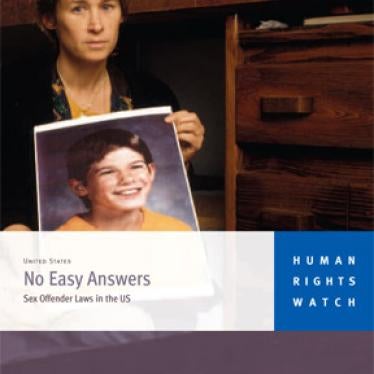The Honorable Ron Marsico
218 Ryan Office Building
PO Box 202105
Harrisburg, PA 17120-2105
The Honorable Thomas R. Caltagirone
106 Irvis Office Building
PO Box 202127
Harrisburg, PA 17120-2127
RE: HB 1958 should not include young offenders
Dear Chair Marsico and Minority Chair Caltagirone:
Human Rights Watch writes to express concern about the impact of House Bill 1958 on Pennsylvania children adjudicated delinquent or found guilty of sex offenses. We ask that you oppose any bill language that requires youthful offenders to participate in the registration and notification requirements under the Federal Sex Offender Registration and Notification Act (SORNA) of the Adam Walsh Act (AWA). We ask that you instead reinforce Pennsylvania’s commitment to the care and rehabilitation of young offenders by removing them from coverage under HB 1958.
Human Rights Watch is an independent organization dedicated to promoting and protecting human rights in the United States and around the globe. The US often stands alone in the world in its excessive punishment of young offenders. We have worked for decades to investigate and advocate against such practices when they violate international human rights law.
The registration and notification scheme in HB 1958 reflects a globally disfavored treatment of young offenders.The Convention on the Rights of the Child, an international treaty ratified by every country in the world save two (the United States and Somalia) establishes the basic standard for treating young offenders. It states that every child accused, adjudicated, or convicted of an offense should be “treated in a manner consistent with the promotion of the child’s sense of dignity and worth” and taking into account “the child’s age and the desirability of promoting the child’s reintegration and the child’s assuming a constructive role in society.”[1] HB 1958 fails to meet this standard by creating a registration scheme for young offenders that can last from 25 years to life. Such a registration requirement runs counter to the goal of the reintegration and rehabilitation of young offenders.
Both science and law have reached the same conclusion: children are different. Studies show that children have less-developed impulse control and have less ability to understand the long-term consequences of their actions. As the Supreme Court noted in Graham v. Florida, “incorrigibility is inconsistent with youth.”[2] Current Pennsylvania law also clearly recognizes the distinction between children and adults. The Pennsylvania Juvenile Act declares its intent to balance accountability, “care and rehabilitation” of the young offender, and developing “competencies to enable children to become responsible and productive members of the community.”[3] HB 1958 ignores this distinction. Its retroactive application subjects a child as young as young as 10 years old to lifetime registration. The bill holds a 10-year-old offender to the same level of culpability as a 30-year-old.
The registration and notification scheme in HB 1958 applies a disproportionate punishment to children. HB 1958 fails to consider the harmful collateral consequences of registration and notification on the lives of young offenders. Residency restrictions can cause enormous problems for registered youth and their families. Young people subject to lifetime registration requirements are banned from federal public housing and Housing Choice Voucher programs. Public notification can spur harmful ostracizing and even vigilante violence against young offenders. Young offenders forced to comply with registration and notification requirements also face colossal barriers in pursuing education or, later in life, employment. Moreover, the mental health impacts for child registrants can cause lasting and devastating harm.
Childhood sexual behavior is uniquely different from adult sexual offending behavior. Studies consistently fail to find a relationship between sexual offenses committed by children and those committed by an adult.[4] The recidivism rate among children who commit sexual offenses is between 4 and 7 percent, and one notable study in 2010 has found the rate to be as low as 1 percent.[5] Compare this to a 13 percent recidivism rates for adults who commit sexual offenses[6] and a national recidivism rate of 45 percent for all prison inmates (regardless of offense).[7]
Other states have determined that compliance with the federal mandate in the AWA is not in their interests.Before passing a bill that can result in irreversible harm to young offenders in Pennsylvania, we ask that you consider other options. We urge you to study the decisions of Texas and New York to not comply with the AWA. Both of these states directly referred to the harms caused by the expansive registration requirements of SORNA. In an August 17, 2011 letter to the Department of Justice, Jeffrey Boyd, General Counsel and Acting Chief of Staff to Governor Rick Perry, wrote: “In dealing with juvenile sex offenders, Texas law more appropriately provides for judges to determine whether registration would be beneficial to the community and the juvenile offender in a particular case.”[8] In a similar letter from the State of New York, Risa Sugarman, Director of the Office of Sex Offender Management, wrote: “New York has a long standing public policy of treating juvenile offenders differently from adult offenders so that juveniles have the best opportunity of rehabilitation and reintegration. The federal requirement that juveniles be placed on the Sex Offender Registry under SORNA is in direct conflict with that public policy.”[9]
We also suggest that you review the experience of your neighboring state of Ohio, which was the first state to comply with the AWA. Between 2009 and 2011, Ohio’s law spawned more than 6,000 lawsuits and increased the workload on sheriffs by over 60 percent.[10] In the past year the Ohio Supreme Court has declared in five separate cases that Ohio’s version of the AWA is unconstitutional.[11] Most recently in State v. Williams, the Ohio Supreme Court held that the stigma attached to sex offenders under the AWA is so significant that the court can no longer label these proceedings as civil in nature. “These restraints on liberty are the consequences of specific criminal convictions and should be recognized as part of the punishment that is imposed as a result of the offender’s actions.”[12]
We thank you for your attention to this matter. If you would like, we would be happy to meet with you at your convenience to further discuss our concerns. Please feel free to contact HRW researcher and Soros Fellow Nicole Pittman, who is based in Philadelphia, to set up a call or in-person meeting.
Sincerely,
Alison Parker
Director, US Program
Human Rights Watch
cc: Members of the Judiciary Committee, Pennsylvania House of Representatives
Christopher Carusone, Esq., Executive Deputy General Counsel, Office of the Governor
[1]Convention on the Rights of the Child (CRC), adopted November 20, 1989, G.A. Res. 44/25, annex, 44 U.N. GAOR Supp. (No. 49) at 167, U.N. Doc. A/44/49 (1989), entered into force September 2, 1990. The United States signed the CRC in 1995 but has not ratified. Article 18 of the Vienna Convention on the Law of Treaties (1969) provides that a state that is a signatory but not yet a party to a treaty “is obliged to refrain from acts which would defeat the object and purpose” of the treaty.
[2]Graham v. Florida, 560 U.S. __, 130 S. Ct. 2011, (2010), quoting Workman v. Commonwealth, 429 S.W. 2d 374, 378 (Ky. App. 1968).
[3]Juvenile Act, 42 Pa.C.S., section 6301 et seq.
[4]Franklin E. Zimring et al., “The Predictive Power of Juvenile Sex Offending: Evidence from the Second Philadelphia Birth Cohort Study,” December 2006, http://papers.ssrn.com/sol3/papers.cfm?abstract_id=995918 (accessed November 30, 2011). See also Margaret A. Alexander, “Sexual Offender Treatment Efficacy Revisited,” Sexual Abuse: A Journal of Research and Treatment, vol. 11 (1999), p. 101-116.
[5]M. Caldwell, “Sexual Offense Adjudication and Recidivism Among Juvenile Offenders,” Sexual Abuse: A Journal of Research and Treatment, vol. 19, p. 107-113. See also E.J. Letourneau et al., “Do sex offender registration and notification requirements deter juvenile sex crimes?” Criminal Justice and Behavior, vol. 37 (2010), p. 553-569.
[6]R. Karl Hanson and Monique T. Bussiere, “Predicting Relapse: A Meta-Analysis of Sexual Offender Recidivism Studies,” Journal of Consulting and Clinical Psychology, vol. 66 (1998), p.348-362.
[7]Pew Center on the States, “State of Recidivism: The Revolving Door of America’s Prisons,” April 2011, http://www.pewcenteronthestates.org/news_room_detail.aspx?id=85899358615 (accessed November 30, 2011). The 45 percent recidivism rate applies to prison inmates released in 1999 who returned to prison within three years due to a new criminal conviction or for violating conditions of release.
[8]North Carolina General Assembly, “SORNA General Information,” October 13, 2011, http://www.ncleg.net/documentsites/committees/JLOCJPS/October%2013,%2020... (accessed November 30, 2011).
[9]Ibid.
[10]Testimony of Amy Borror, Office of the Ohio Public Defender,Hearing on the Sex Offender Registration and Notification Act (SORNA), US House of Representatives, Committee on the Judiciary, Subcommittee on Crime, Terrorism, and Homeland Security,March 10, 2009, http://judiciary.house.gov/hearings/pdf/Borror090310.pdf (accessed November 30, 2011).
[11]State v. Williams, 129 Ohio St.3d 344, 2011-Ohio-3374; State v. Bodyke, 126 Ohio St.3d 266, 2010-Ohio-2424; In re D.J.S., Slip Opinion No. 2011-Ohio-5342; In re A.R., Slip Opinion No. 2011-Ohio-5344; In re A.R.R. , Slip Opinion No. 2011-Ohio-5346.
[12]State v. Williams, 129 Ohio St.3d 344 (2011).







